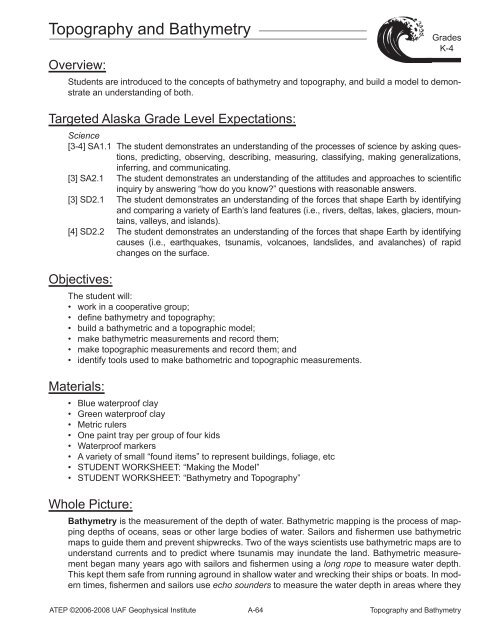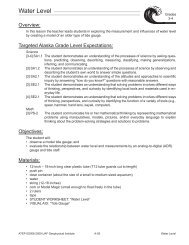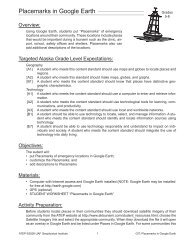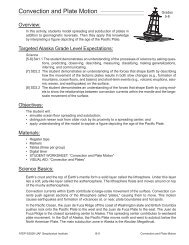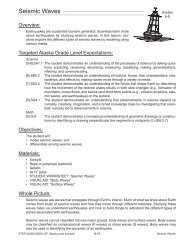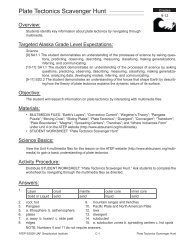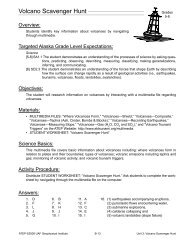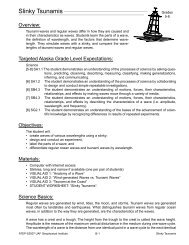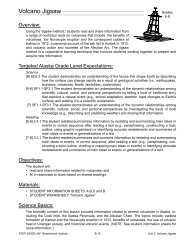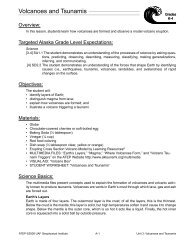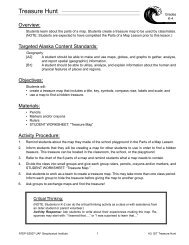Topography and Bathymetry
Topography and Bathymetry
Topography and Bathymetry
Create successful ePaper yourself
Turn your PDF publications into a flip-book with our unique Google optimized e-Paper software.
<strong>Topography</strong> <strong>and</strong> <strong>Bathymetry</strong><br />
Overview:<br />
Grades<br />
K-4<br />
Students are introduced to the concepts of bathymetry <strong>and</strong> topography, <strong>and</strong> build a model to demonstrate<br />
an underst<strong>and</strong>ing of both.<br />
Targeted Alaska Grade Level Expectations:<br />
Science<br />
[3-4] SA1.1 The student demonstrates an underst<strong>and</strong>ing of the processes of science by asking questions,<br />
predicting, observing, describing, measuring, classifying, making generalizations,<br />
inferring, <strong>and</strong> communicating.<br />
[3] SA2.1 The student demonstrates an underst<strong>and</strong>ing of the attitudes <strong>and</strong> approaches to scientific<br />
inquiry by answering “how do you know?” questions with reasonable answers.<br />
[3] SD2.1 The student demonstrates an underst<strong>and</strong>ing of the forces that shape Earth by identifying<br />
<strong>and</strong> comparing a variety of Earth’s l<strong>and</strong> features (i.e., rivers, deltas, lakes, glaciers, mountains,<br />
valleys, <strong>and</strong> isl<strong>and</strong>s).<br />
[4] SD2.2 The student demonstrates an underst<strong>and</strong>ing of the forces that shape Earth by identifying<br />
causes (i.e., earthquakes, tsunamis, volcanoes, l<strong>and</strong>slides, <strong>and</strong> avalanches) of rapid<br />
changes on the surface.<br />
Objectives:<br />
The student will:<br />
• work in a cooperative group;<br />
• define bathymetry <strong>and</strong> topography;<br />
• build a bathymetric <strong>and</strong> a topographic model;<br />
• make bathymetric measurements <strong>and</strong> record them;<br />
• make topographic measurements <strong>and</strong> record them; <strong>and</strong><br />
• identify tools used to make bathometric <strong>and</strong> topographic measurements.<br />
Materials:<br />
• Blue waterproof clay<br />
• Green waterproof clay<br />
• Metric rulers<br />
• One paint tray per group of four kids<br />
• Waterproof markers<br />
• A variety of small “found items” to represent buildings, foliage, etc<br />
• STUDENT WORKSHEET: “Making the Model”<br />
• STUDENT WORKSHEET: “<strong>Bathymetry</strong> <strong>and</strong> <strong>Topography</strong>”<br />
Whole Picture:<br />
<strong>Bathymetry</strong> is the measurement of the depth of water. Bathymetric mapping is the process of mapping<br />
depths of oceans, seas or other large bodies of water. Sailors <strong>and</strong> fishermen use bathymetric<br />
maps to guide them <strong>and</strong> prevent shipwrecks. Two of the ways scientists use bathymetric maps are to<br />
underst<strong>and</strong> currents <strong>and</strong> to predict where tsunamis may inundate the l<strong>and</strong>. Bathymetric measurement<br />
began many years ago with sailors <strong>and</strong> fishermen using a long rope to measure water depth.<br />
This kept them safe from running aground in shallow water <strong>and</strong> wrecking their ships or boats. In modern<br />
times, fishermen <strong>and</strong> sailors use echo sounders to measure the water depth in areas where they<br />
ATEP ©2006-2008 UAF Geophysical Institute A-64 <strong>Topography</strong> <strong>and</strong> <strong>Bathymetry</strong>
do not have maps. Scientists use satellites <strong>and</strong> other precise instruments to make their bathymetric<br />
measurements.<br />
<strong>Topography</strong> is the measurement of natural l<strong>and</strong> features such as mountains, hills, streams, rivers,<br />
plateaus, banks, crevasses, canyons, etc. Topographic measurements are important to many people.<br />
Farmers use the information to help determine where <strong>and</strong> when to plant crops. Hikers use topographic<br />
maps to help them determine their location. Builders decide where <strong>and</strong> how to build structures using<br />
topographic information. It is also important in planning the structure <strong>and</strong> locations of roads <strong>and</strong><br />
bridges. Coastal communities need to consider topography for the sake of safety. Topographic information<br />
can help make communities aware of likely areas of flooding, earthquake danger, <strong>and</strong> tsunami<br />
hazard <strong>and</strong> escape routes to safe areas. Scientists, engineers <strong>and</strong> surveyors use satellite data <strong>and</strong><br />
other instruments to create topographic maps to aid all these people.<br />
Activity Preparation:<br />
1. Write the words <strong>Bathymetry</strong> <strong>and</strong> <strong>Topography</strong> on the board or chart paper. Ask students if they have<br />
any idea what these words mean. Allow thinking time. If no one answers underline the letters bath <strong>and</strong><br />
topo. Tell students this is a clue <strong>and</strong> that one word is related to the ocean, one to l<strong>and</strong>. Allow think<br />
time, then, if still no answer tell them they can help remember by thinking bath = water <strong>and</strong> topo = the<br />
l<strong>and</strong> (which is above the water). Next underline metry <strong>and</strong> tell students that this suffix refers to measuring<br />
(meters). The two parts of the word mean measuring water. Now look at the word topography.<br />
Establish that topo actually means place. Ask if they can figure out what graphy means. Allow think<br />
time. Confirm or explain that graphy means drawing. Define topography as the drawing <strong>and</strong> measurement<br />
of the l<strong>and</strong> surfaces of the earth.<br />
2. Proceed to the discussion of science basics.<br />
Activity Procedure:<br />
1. Have groups of four students work cooperatively to make a topographic <strong>and</strong> bathymetric model. Use<br />
a paint roller tray to simulate the ocean floor <strong>and</strong> l<strong>and</strong>. Use blue waterproof clay to simulate underwater<br />
features <strong>and</strong> green waterproof clay to simulate l<strong>and</strong> features. Tell students they must represent at<br />
least the following underwater (bathymetric) features: a ridge, a trench, small rises in the ocean floor,<br />
<strong>and</strong> an isl<strong>and</strong>. Their l<strong>and</strong> (topographic) features should include, at the very least: hills, mountains, a<br />
lake, a river, <strong>and</strong> a cliff.<br />
2. When the construction of the model is complete, have students add water to the tray to the depth at<br />
which the l<strong>and</strong> <strong>and</strong> sea meet. Pass out the STUDENT WORKSHEET: “Making the Model.” Have students<br />
take turns using a metric rule to measure <strong>and</strong> record the depth of their ocean <strong>and</strong> the height of<br />
their l<strong>and</strong> features on the worksheet.<br />
Critical Thinking Questions: Why is it important for scientists to underst<strong>and</strong> the shape of the ocean<br />
floor? Who do you think this information can help? Why is it important to know the shape of the l<strong>and</strong><br />
surfaces of the Earth?<br />
Answers:<br />
1. Student should write “B” on the satellite, depth finder, <strong>and</strong> submarine.<br />
2. Student should circle the computer, satellite, <strong>and</strong> tripod with instrument.<br />
3. Words should match definitions.<br />
4. Student should underline the letters “topo” <strong>and</strong> “bath.”<br />
5. All of the above<br />
6. Answers vary, but could include farmers, hikers, builders, etc.<br />
7. Answers should reflect underst<strong>and</strong>ing.<br />
ATEP ©2006-2008 UAF Geophysical Institute A-65 <strong>Topography</strong> <strong>and</strong> <strong>Bathymetry</strong>
Name:____________________________________<br />
<strong>Topography</strong> <strong>and</strong> <strong>Bathymetry</strong><br />
Student Worksheet (1 of 2)<br />
Grades<br />
K-4<br />
1. Write a B on the pictures of things that might be used in bathymetry.<br />
depth finder<br />
telescope<br />
satellite<br />
tape measure<br />
computer<br />
submarine<br />
pencil<br />
2. Circle the tools used to make a topographic map.<br />
screwdriver<br />
pencil<br />
hammer<br />
ruler<br />
electronic<br />
distance<br />
meter<br />
satellite<br />
computer<br />
ATEP ©2006-2008 UAF Geophysical Institute A-66 <strong>Topography</strong> <strong>and</strong> <strong>Bathymetry</strong>
Name:____________________________________<br />
<strong>Topography</strong> <strong>and</strong> <strong>Bathymetry</strong><br />
Student Worksheet (2 of 2)<br />
Grades<br />
K-4<br />
3. Draw lines to match each word with its definition.<br />
<strong>Bathymetry</strong><br />
<strong>Topography</strong><br />
measuring <strong>and</strong> drawing the surface<br />
features of Earth<br />
measuring the depth of the ocean to<br />
underst<strong>and</strong> its shape <strong>and</strong> features<br />
4. Underline the letters in #3 that helped you remember which definition<br />
matched.<br />
5. Put a check next to each group of people could be helped by underst<strong>and</strong>ing<br />
the bathymetry of the ocean.<br />
____<br />
____<br />
____<br />
____<br />
Fishermen<br />
People who live near the coast<br />
Scientists<br />
All of the above<br />
6. Name a group of people who would find it important to underst<strong>and</strong> the<br />
topography of the l<strong>and</strong>. _________________________________________<br />
7. Tell why this would be important to them. ____________________________<br />
____________________________________________________________<br />
____________________________________________________________.<br />
ATEP ©2006-2008 UAF Geophysical Institute A-67 <strong>Topography</strong> <strong>and</strong> <strong>Bathymetry</strong>
Name:____________________________________<br />
Making the Model<br />
Student Worksheet (1 of 2)<br />
Grades<br />
K-4<br />
Measurement Record<br />
Student group______________________________________________________<br />
<strong>Bathymetry</strong><br />
1. The deepest point of our ocean measured__________________ centimeters.<br />
2. The shallowest point in our ocean measured ________________centimeters.<br />
3. We made the following underwater features:<br />
______________________________________________________________<br />
______________________________________________________________<br />
<strong>Topography</strong><br />
1. Use a ruler to measure the highest mountain you built. Record its height here.<br />
Our mountain is ________________centimeters high.<br />
2. Draw a side view of your mountain labeling the height.<br />
ATEP ©2006-2008 UAF Geophysical Institute A-68 <strong>Topography</strong> <strong>and</strong> <strong>Bathymetry</strong>
Name:____________________________________<br />
Making the Model<br />
Student Worksheet (2 of 2)<br />
Grades<br />
K-4<br />
3. For Extra Credit: Pick two other topographic features you built. Draw one from<br />
the side. Draw the other as it would look from the air. Label each to indicate the<br />
height.<br />
ATEP ©2006-2008 UAF Geophysical Institute A-69 <strong>Topography</strong> <strong>and</strong> <strong>Bathymetry</strong>


